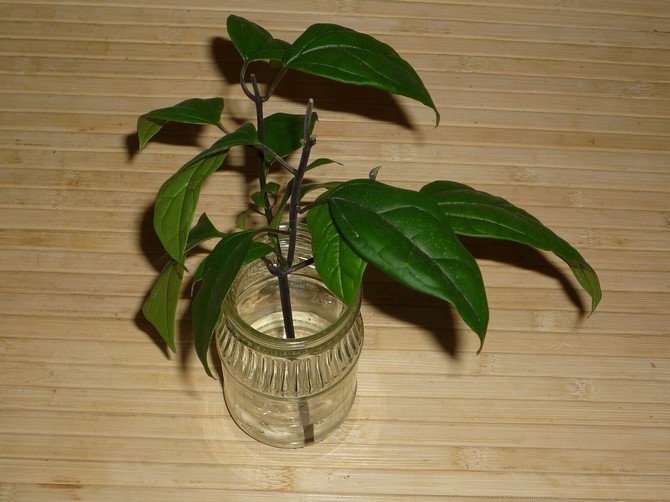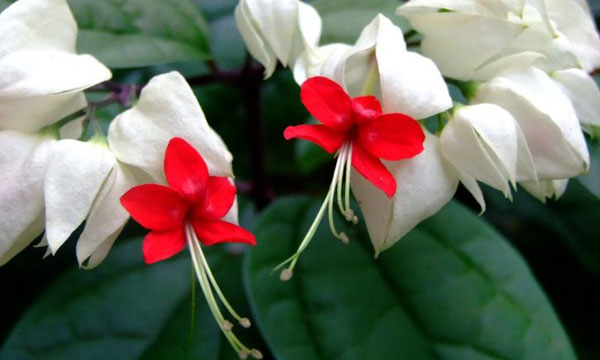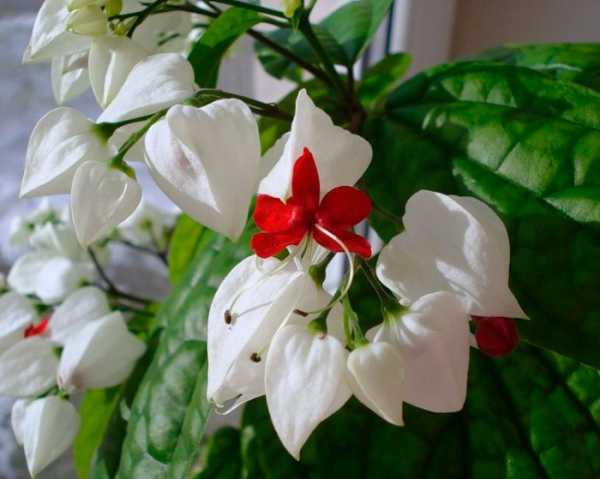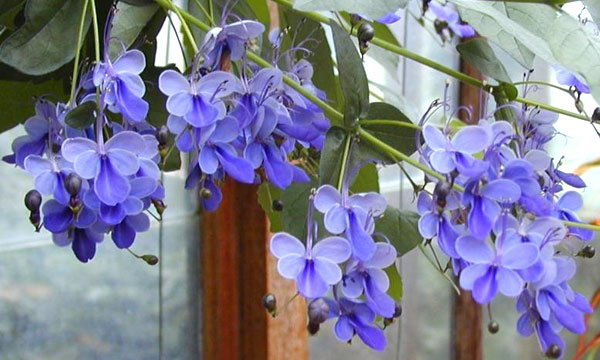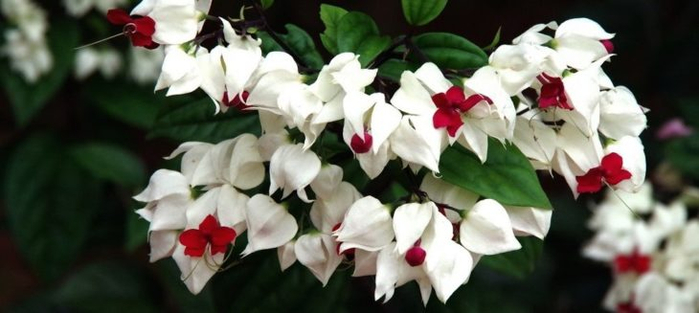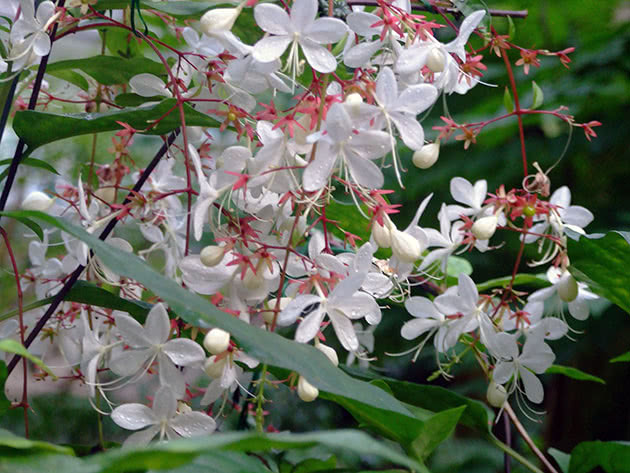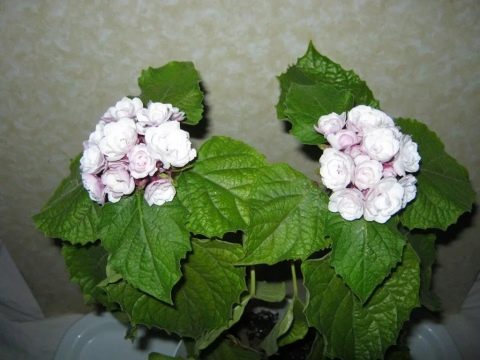The most common types and their features
Due to its simple content and spectacular appearance, clerodendrum is widely used by designers to decorate the interior.
Clerodendrum Thompson
Clerodendrum Thompson can be called a climbing shrub, as it releases shoots that can twine like a vine. In nature, they can grow up to 4 meters in length.

White flowers with red corollas look very impressive. They are collected in cluster-shaped inflorescences. After the end of flowering, the closed cups change from white to pink or lilac.

It got its name in honor of George Thompson, who first brought it to Europe. The flower of this species also has another name, which was named after the discoverer's wife - "Mrs. Thompson's clerodendrum."
Clerodendrum Filipino

Clerodendrum Filipino is a shrub that is quite common as an indoor crop. Stems are erect, in conditions of an apartment it reaches 2 meters in height. The leaves are large, heart-shaped. Fragrant double flowers, reminiscent of roses, are collected in inflorescences.
Clerodendrum Ugandan
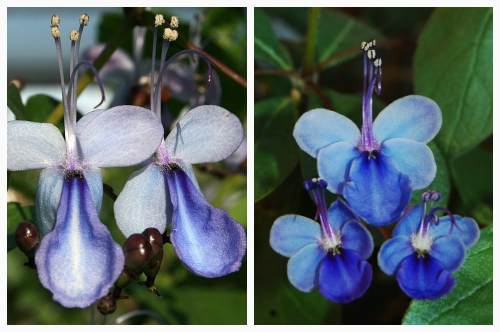
Clerodendrum Ugandan is a fast-growing vine that winds around a support in a short time. It grows in length up to 2 - 3 meters. Delicate flowers of a blue-blue hue, resemble fluttering butterflies in shape.
Unlike other species, it has a specific smell that not everyone may like.
Clerodendrum Inerme

Clerodendrum inerme (unarmed) is a vine that is quite rare at home. In hot climates, it can be used as a hedge. The flowers in the photo are white and contrast with the bright purple stamens.
Reproduction of clerodendrum
The main breeding method for clerodendrum is cuttings. Twigs left over after pruning can be used as planting material. Cuttings harvested in early spring root best of all, in the rest of the year the degree of their survival rate is much lower. For most species, the rooting process is quite long, it can take several months, and the percentage of established seedlings is small. To accelerate the process of root formation, it is recommended to use various phytohormones: root, heteroauxin, etc.
Rooting is best done in water, followed by planting in the ground. Different species have different reproductive capacities. So, in the Ugandan clerodendrum, semi-lignified cuttings quickly form roots, and in the bunge, their rooting can take up to six months. This species sometimes forms root shoots, which are successfully used for reproduction. In the Philippine Clerodendrum, young plants can be grown from root segments, using mini-greenhouses for rooting, or, like the previous species, by planting root shoots. In Clerodendrum Wallis, cuttings are rooted in the substrate, having previously been treated with growth stimulants and providing additional lighting.
All species can be propagated by seed.
Clerodendrum Ugandan: home care
Creation of favorable conditions for Ugandan Clerodendrum and care at home does not take much time. The plant is unpretentious in cultivation, so you do not need to have special skills. Basically, you need to monitor lighting, air humidity, careful watering and temperature conditions. After the flowers bloom, pruning and pinching are required so that the plant blooms well for the next year. If you properly care for the plant constantly, then you will not need treatment for diseases and pests.

Growing on a windowsill
Temperature regime
For healthy growth of clerodendrum in northern latitudes, it is necessary to maintain a certain temperature. In the summer season, the tree functions actively, but in the winter it needs peace. For this, the room temperature is lowered to 19 ° C. This method helps the plant gain strength and bloom profusely from the beginning of spring. From March to November, the temperature regime for growing the bush is maintained in the range from 19 ° C to 25 ° C.
Air humidity
The basis for the care of Clerodendrum, nicknamed the tree of fate, is to maintain a high level of humidity. In room conditions, it is not always possible to maintain a certain level of humidity. Regular spraying with soft and slightly cool water will help to increase it in a dry, heated room. For additional moisture, the pot is placed on a pallet with water, a container with water is placed near it, or a damp cloth is placed on the heating pipe under the windowsill.
Leaving during flowering
Caring for the clerodendrum tree of fate during flowering includes periodic feeding, maintaining a favorable temperature and moderate watering.
During flowering, the plant is fed with complex organic and mineral preparations. Especially at this time, it is recommended to increase the potassium content in the soil, which affects the lush and abundant flowering. But nitrogen-containing fertilizers should be reduced, and it is better to stop altogether for a while. To prevent the appearance of chlorosis, the plant is treated and sprayed with preparations containing iron.
Important! Watering is carried out with soft, slightly warm water, it is better to use river or rain water
Flowering time
Clerodendrum blue butterflies bloom for a long period, but not all year round, like another species of Clerodendrum Uruguay. Blooming of buds begins in April after pruning old branches. Flowering continues until November. Then the vine must be sent to rest to accumulate strength.

Clerodendrum Ugandan
Types and varieties of clerodendrum
Clerodendrum Prospero, also called Cleopatra's tears. The most capricious species to grow comes from Bangladesh, India and southern China.

It got its name in honor of the Danish botanist and explorer Wallich Nathaniel, who discovered this species while participating in scientific expeditions to India.
Plant height is about half a meter. Its characteristic feature is large, shiny dark green, leathery leaves with wavy edges about 15 cm in length. Numerous snow-white flowers are collected by drooping brushes. Wallich's Nathaniel was in awe of the exotic beauty of Clerodendrum Prospero.
Clerodendrum thomsoniae. The most common species in indoor culture is native to West Africa. It got its name in honor of the missionary priest and physician William Cooper Thomson, who spent a lot of time in Nigeria. The elastic shoots of the evergreen vine are covered with large leaves with visible veins.

The flowers are bright red tubular, surrounded by snow-white, pink or pale purple or red bell-shaped bracts, collected in racemose loose inflorescences.
In addition to the magnificent flowering of this species, there are decorative deciduous hybrids of the Variegatum group with marbled green foliage, which complements the beauty of the flowers.
 Clerodendrum variegated
Clerodendrum variegated
The popular and showy variety Delectum with pink-purple flowers in very large inflorescences, Bleeding Heart Vine with bright red blooms.
Clerodendrum Ugandan (Ugandan Clerodendrum) is native to the mountainous regions of East Africa. One of the most famous species, which is often called the "Blue Butterfly" because of the special shape of the flowers.
The plant is a fast-growing liana about 2 m long. The inflorescence consists of 5 flowers of a pale blue or purple hue. The pruning procedure allows you to form a bush shape.

Clerodendrum speciosum is another member of the genus native to Polynesia and New Guinea.
It is a bush with scarlet flowers and pink bracts, abundant flowering throughout the summer.

Clerodendrum Filipino (C. philippinum). A fast-growing shrub species that is easy to care for and blooms already at 2 years of age.
It is characterized by beautiful large double flowers with a strong jasmine aroma with hints of vanilla.
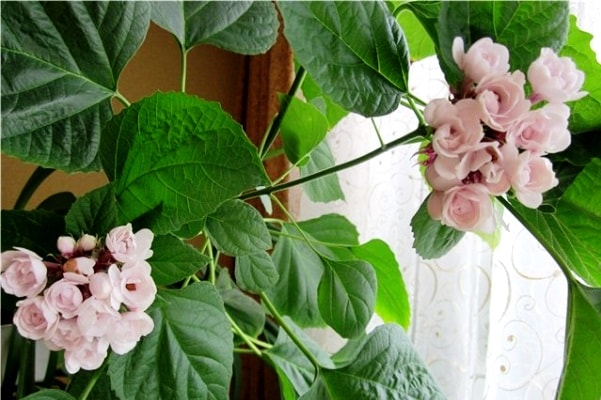
Clerodendrum Schmidt (C. schmidtii) is a shrub or small tree with several stems and drooping shoots.
White, fragrant flowers cascading in loose, long inflorescences. Fully open, the flowers resemble white butterflies.
Flower stems are dark red.
Blossoming is predominantly winter.
Can be grown both on a stem and in hanging pots.

Clerodendrum inerme. A hardy, branching shrub with long, flexible shoots, reaching a height of 3 meters in its natural habitat, but at home, the height is controlled by pruning. Good for growing bonsai.
The leaves are almost round, shiny. The plant blooms almost all the time. The flowers are white and very fragrant, with long purple stamens. There is also a variegated form of the plant with golden green leaves.

Clerodendrum splendens is an evergreen woody vine capable of up to 3-4 m in length.
The leaves are large, ovoid, shiny, panicle inflorescences 12-15 cm in diameter, composed of bright scarlet flowers. Blooming almost all year round.

Clerodendrum Bunge (C. Bungei). A short bush with large, unpleasantly smelling ovoid leaves.
Young leaves often have a purple hue.
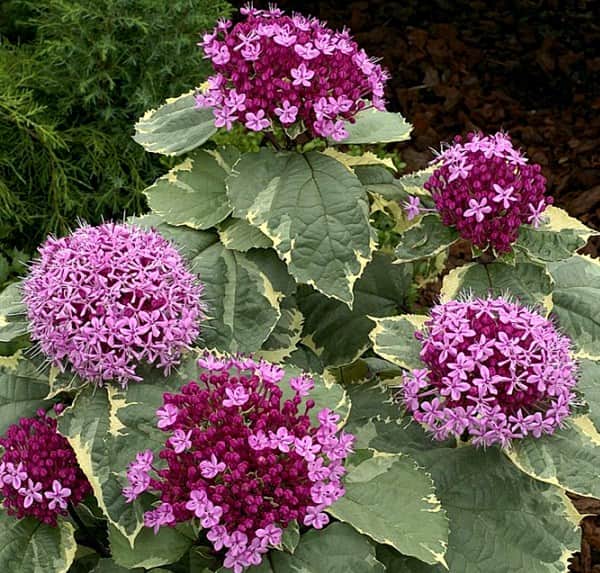 "Pink Diamond"
"Pink Diamond"
Fragrant pink flowers are collected in a rounded inflorescence. Popular variety with variegated foliage: "Pink Diamond". Bloom from late summer and throughout autumn.
Reproduction
Reproduction takes place by cuttings. Stems with 3-4 leaf nodes take root best. They must be cut off from the lower stems. Shoots take root in water or in a moist substrate. For this, peat and fine-grained sea sand are added to the soil.
The optimum temperature for growth is 20-22 ° C. The containers are chosen no more than 15 cm in diameter. Initially, 2-3 cuttings can be planted in them.
From above, you need to build a mini-greenhouse from a cut plastic bottle. It retains moisture and helps the plant take root faster.
In natural light, rooting is slow and weak. It may take 1-1.5 months. Therefore, the seedlings are preliminarily treated with growth stimulants.
Zircon, Kornevin, Heteroauxin are perfect. They significantly speed up the rooting process.
With special artificial lighting, rooting is faster. It may take 1-1.5 weeks.
As soon as the sprouts take root, they begin to be fed. After a month, the seedlings can already be transplanted into other containers.
In the autumn, they can bloom. But the first bloom is weak and not abundant. Active growth and flowering occurs from the second year of life.
How to care for clerodendrum
The place for the plant is chosen so as to provide it with bright diffused lighting. Best suited for these purposes are east and west windows, on the north, due to a lack of light, the bush will not bloom, and may even shed its leaves. On the south windows shading is required at noon hours.
The most favorable temperature regime is moderate heat (from 18 ° C to 25 ° C) throughout the year, with the exception of a short period of rest, when the temperature is lowered to 12-18 ° C.
The culture does not tolerate dry air, maintaining its high humidity is an essential element of care. Clerodendrum needs regular spraying, which is best done in the evening using soft, previously settled water.For additional moisture in the summer, it is recommended to place the pot on a pallet filled with wet moss, pebbles or expanded clay. In winter, the plant should not be kept close to central heating radiators. It is better not to spray during the cool wintering period.
Rapid growth and abundant flowering in the spring and summer require abundant watering, while, since all species are very sensitive to stagnant water, its surplus from the pan is necessarily drained. If the plant is kept cool in winter, watering is limited, at the same time preventing the earthen coma from completely drying out. It is better to use soft water, without chlorine impurities.
Pests and methods of struggle
The flower is not very susceptible to pests, but the following are most common.
Whitefly

Whitefly lesions are easy to spot. When the branches of the plant are shaken, a cloud of very small white butterflies appears. They settle on the back of the leaves and look like a white bloom. Yellow eggs can also be seen there.
Spider mite
The appearance of this pest makes it possible to suspect the leaves, which begin to turn yellow and fall off. On their reverse side, a thin cobweb will be noticeable, entangling a leaf, along which microscopic points - spider mites move.
Shield
The scabbard can be located on any part of the plant, both on the leaves and on the stems. It is quite difficult to fight this insect, since it protects itself and the eggs with the shell under which it is located.

You can fight pests in the following ways:
- Destruction of heavily infested leaves.
- The physical way is to rinse the leaves with soapy water using a soft sponge and then rinse the plant.
- Using whitefly glue traps. They are used to catch adult flying insects.
- Spraying with insecticides, such as "Aktellik", "Aktara". Preparations are diluted in concentration, according to the instructions, depending on the type of pest.
Compliance with the rules of maintenance and care, as well as regular inspection of plants will prevent the appearance of pests. And their early detection will allow you to fight with the greatest efficiency.
"The tree of fate" will be a wonderful decoration for any interior and will surely bring good luck to your home.
Clerodendrum Ugandan
Clerodendrum Ugandan is gaining immense popularity among connoisseurs of exotic plants and ordinary flower growers living in the middle latitudes. But the evergreen plant itself grows in Africa and Asia, and is used for decorative purposes.

Ugandan view in pots
Botanical description of the plant
Clerodendrum Ugandan is an evergreen perennial plant that belongs to the Verbenaceae family. It has lignified thin shoots, therefore it is referred to as half-lianas and semi-shrubs. Shoots can stretch up to 2.5 m in length. The dark green leaf reaches a size of 10 cm, the shape of the leaf is lanceolate with a serrated edge, and there are also smooth edges.
The flower is bright blue in color with large petals, which is very similar to a blue butterfly. One bud contains five petals, each of which is different in color and shape from the others. The one in the middle is much darker than the others and is curved in the shape of a boat. At the very end of the bud are yellow stamens.

Blue butterflies
A beautiful legend about the tree of fate
The literal translation of the name of the flower means “the tree of fate”. There is a legend that came from the island of Java from Indonesia. It says that the tree has tremendous power. It can bring joy and happiness to your home.
The African peoples have a similar legend. They are known to have worshiped the tree. It was under it that significant rituals of African residents took place. They believed that the clerodendrum tree of fate is capable of attracting only good and happy emotions, as well as good luck and luck.
For your information! It is believed that the flowers of the Ugandan clerodendrum in ancient Rome decorated the temple of the goddess of love Venus.
Why is Clerodendrum Ugandan valuable?
Clerodendrum Ugandan is prized primarily for its beautiful and long flowering. Particularly interesting is the shape of the flowers in the form of blue butterflies, which makes the bush more desirable for gardeners to acquire than the white species - clerodendrum calamitosum
The pleasant aroma emanating from the flowers also attracts attention.
Some gardeners get this look because of the unusual legend associated with the plant. Some believe that it really has the ability to bring good luck and joy.
Possible problems and solutions
- As the owner of delicate and thin leaves, clerodendrum is susceptible to sunburn. With this problem, it is necessary to change the location of the plant.
- Dry spots are caused by a draft that the plant is exposed to.
- Infection with a spider mite causes yellowing of the leaves (why do the leaves turn yellow and fall off in Clerodendrum?). Prevention will be regular watering and spraying.
- Fungal diseases can be eradicated with a solution of fufan or karbofos.
- The lack of flowering can be caused by a violation of the dormant period of the clerodendrum.
Both an experienced gardener and an amateur can please themselves with the unusual flowering of clerodendrum. To become the owner of this flower, you only need to collect seeds at the beginning of spring from another plant or cut a stalk from it. The breeding procedure in any of these ways is easy and straightforward. By adhering to simple rules, you can quickly get a healthy adult plant.
The variety of colors of clerodendrum is simply amazing
Due to the fact that recently florists and botanical breeders have paid attention to this plant, more and more new species and varieties have begun to appear.


